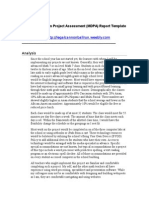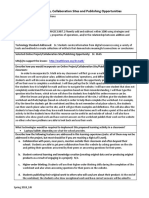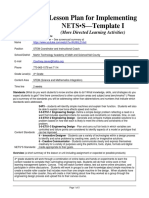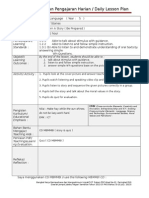Flaucher 5elp Functions Lesson Plan
Flaucher 5elp Functions Lesson Plan
Uploaded by
api-379231469Copyright:
Available Formats
Flaucher 5elp Functions Lesson Plan
Flaucher 5elp Functions Lesson Plan
Uploaded by
api-379231469Original Title
Copyright
Available Formats
Share this document
Did you find this document useful?
Is this content inappropriate?
Copyright:
Available Formats
Flaucher 5elp Functions Lesson Plan
Flaucher 5elp Functions Lesson Plan
Uploaded by
api-379231469Copyright:
Available Formats
5E Lesson Plan Ideas Cheryl Flaucher
Subject area/course/grade level (2 points):
Math/Algebra 2/11-12th grade
Transformations of Parent Functions
Standards (State and ISTE Standards for Students) (2 points):
ISTE Standards
4a Students know and use a deliberate design process for genera ng ideas, tes ng theories, crea ng innova ve ar facts or
solving authen c problems.
7c Students contribute construc vely to project teams, assuming various roles and responsibili es to work eec vely toward
a common goal.
2b Students engage in posi ve, safe, legal and ethical behavior when using technology, including social interac ons online or
when using networked devices.
ALCOS Algebra 2, Standard 34. Iden fy the eect on the graph of replacing f(x) by f(x) + k, k f(x), f(kx), and f(x + k) for specic
values of k (both posi ve and nega ve); nd the value of k given the graphs. Experiment with cases and illustrate an
explana on of the eects on the graph using technology. Include recognizing even and odd func ons from their graphs and
algebraic expressions for them. [F-BF3]
ALCOS Algebra 2, Standard 30. Graph func ons expressed symbolically, and show key features of the graph, by hand in
simple cases and using technology for more complicated cases.* [F-IF7]
Objec ves (2 points):
The students will explore and analyze transforma ons of func ons.
The students will manipulate parent func ons to perform transforma ons of func ons.
The students will reinforce technology skills.
Dieren a on Strategies (4 points):
How will the lesson address the various learning styles of the students and the needs of those with special needs?
This lesson will include the following accommoda ons:
1. Allow extra me if needed.
2. Use peer tutors, as well as student-teacher conferences.
3. Underline or call special a en on to important direc ons and key terms.
4. Use visuals and manipula ve materials.
5. Give direc ons orally as well as wri en.
6. Give immediate feedback and lots of encouragement throughout ac vi es.
7. Consider modifying assignments based on mul ple intelligences.
8. Provide a copy of lled in notes.
ENGAGEMENT (18 points):
Here is your chance to catch the students a en on. Describe two ac vi es u lizing technology to help the students build on
what they already know in prepara on for learning something new. Provide a sample of each activity. URLs may be needed to
show samples. Get the students excited about learning!
Approved January, 2013
Activity 1
To assess my students prior knowledge of parent func ons, they will review the study set of Quizlet ashcards and then play
the match and gravity games in groups of 2 or 3 on the class set of Chromebooks. Students will sign in on their Quizlet accounts
so their mes will be recorded. Students may work individually if preferred.
h ps://quizlet.com/222224550/parent-func ons-ash-cards/
Activity 2
On the projector, we will watch two YouTube videos on parent func ons and we will discuss them. Then, in groups of 4,
students will search YouTube using their phones or the Chromebooks to nd a parent func ons rap, song, or dance that they
like. They will use this as a model to create their own lyrics or dance video to describe the parent func ons that they are
assigned. This will also provide them with a preview of transforma ons that we will be learning in this lesson. We will use a
laptop connected to the projector to watch the completed projects.
The class videos that will be shown are h ps://www.youtube.com/watch?v=58ZmkhlanZA (song) and
h ps://www.youtube.com/watch?v=eJVeNVR3XPA (dance). A copy of the rubric can be found at
h ps://www.rcampus.com/rubricshowc.cfm?code=JX8C427&nocache=1505098060785 that will be used for grading the
projects.
Direc ons sheet and rubric
References
Coder, H. (2013, October 17). Parent func on dance. Retrieved from YouTube:
h ps://www.youtube.com/watch?v=eJVeNVR3XPA
Ground, Mr. (2010, September 14). Math shorts #1 Parent Func ons. Retrieved grom YouTube:
h ps://www.youtube.com/watch?v=58ZmkhlanZA
EXPLORATION (18 points):
This is it, the heart of learning. Hands-on experiences are mandatory and should include chances for the students to
collaborate and experiment and be able to discuss their learning with others. Describe two ac vi es u lizing technology that
allow students to collaborate and discuss content. Provide a sample of each activity.
Activity 1
Students will be assigned a partner and they will be given graphing calculators to explore what happens as the parent func on
equa ons are manipulated following the document that has been shared with the students on Google Docs. There will be
printed copies for students that experience technical dicul es. They should type their answers on the document and shared
with the teacher when they have completed the ac vity. This is a link the students can refer to if they have forgo en how to
use the graphing calculators.
h p://www.dummies.com/educa on/graphing-calculators/ -84-plus-graphing-calculator-for-dummies-cheat-sheet/
Student Graphing Calculators sheet.
Activity 2
Students will be in pairs and use the Chromebooks to play the Scirra Arcade quadratic transformations slide activity. The
ac vity tells the player to move dots to represent the placement of the parabola a er a given transforma on.
The game URL: https://www.scirra.com/arcade/other-games/quadratic-transformations-2901
Approved January, 2013
EXPLANATION (18 points):
This stage of the lesson is your part. Clear up any misconcep ons from the explora on ac vity, cover vocabulary, concepts,
ideas whatever is necessary to help the students understand the content. Include higher order thinking ques ons to help
the students connect and comprehend the point of the lesson. Create a presentation using a technology tool other than
PowerPoint to help your students understand the content; include higher order thinking ques ons in the presenta on.
Student will watch my video lesson which gives a review of parent func ons and a closer look at transforma ons. Students will
take notes on the note taker as I am going over the problems. There is also a graphic organizer to summarize the video lesson.
This notes sheet and graphic organizer has been shared with the students on Google Docs so they can access it digitally, but I
will also provide a hard copy if needed. At the end of the lesson there are 5 higher order thinking ques ons for students to
explore along with a challenge problem. Once students nish watching the video lesson, they will log onto www.Socra ve.com
(specic details are below in the evalua ons sec on). They will complete the online quiz so I can assess their understanding of
the lesson.
My Video lesson link: https://youtu.be/iIh-CP3Ulvc
note taker and graphic organizer.
ELABORATION (18 points):
This is your chance to plan ac vi es for the students to apply what they learned in the lesson to their lives and new situa ons.
You will need to be crea ve and allow your students to do the same. Design 2 assignments that require students to create a
technology product to demonstrate their understanding of the content taught. Once assignment should be a collabora ve
group project and one an individual product. Provide a sample technology product of each.
Assignment 1
As a chance to use transforma ons to create a picture, students will use Desmos to create a picture incorpora ng the parent
func ons or transforma ons. This will be an individual project. I will show the students an example picture that I have created
and provide a direc ons sheet along with the rubric so students will know what is expected of them and how they will be
graded. Once they have completed their pictures, they will post the link to the Edmodo class page. The picture I created on
desmos https://www.desmos.com/calculator/trhifx3j8s The rubric link is
http://www.RCampus.com/rubricshowc.cfm?code=BX8C333&sp=true&nocache=1504998171111
Direc ons sheet and rubric.
My sample Desmos co age.
Assignment 2
As a group project, students will form groups of 2 or 3 and create PowerPoint or Prezi of the transforma ons we have covered
in this lesson. Students will have to include all 6 of the transforma ons and 6 of the parent func ons discussed. The students
Approved January, 2013
will be given a direc ons sheet and rubric when the project is assigned so they will know what is expected, and how they will
be graded. Students will present their completed projects to the class.
PowerPoint direc ons sheet and rubric and PowerPoint example. The rubric link is
h ps://www.rcampus.com/rubricshowc.cfm?code=RX8C494&nocache=1505146276704
EVALUATION (18 points):
Assessment is part of each stage of the 5E lesson plan process. You will need to assess each student on their par cipa on and
understanding and evaluate how close they have come to mee ng the objec ves of the lesson. Explore the following
resources to create assessments to evaluate students learning outcomes for each of the lessons being taught.
Plickers-h ps://www.graphite.org/app/plickers
Kahoot-h ps://getkahoot.com/
Scocra ve-h p://www.socra ve.com/
Poll Everywhere-h p://www.polleverywhere.com/
iRubric - h p://www.rcampus.com/indexrubric.cfm
Rubistar - h p://rubistar.4teachers.org/index.php
Annenberg Learner Build a Rubric - h p://www.learner.org/workshops/hswri ng/interac ves/rubric/
Create a rubric to assess the group projects and individual student products using a free online rubric maker. Also, create a
forma ve assessment for each lesson using one of the tools above, exclucing the rubric makers.
Provide a sample of each rubric and formative assessment.
Engagement Assessment
1) I will check their progress on the quizlet games.
2) The students will be given a rubric to guide them in crea ng their projects. This rubric will used to evaluate and grade the
YouTube song or dance project the groups have created.
h ps://www.rcampus.com/rubricshowc.cfm?code=JX8C427&nocache=1505098060785
Exploration Assessment
A er comple ng the explora on exercises with the graphing calculators and slide ac vity, the class will use the Plickers cards to
answer some forma ve assessment ques ons about the parent graphs. This will help assess the classs understanding of parent
func on graphs and equa ons that go with the graphs. The Plickers sign in site is www.Plickers.com. Use the following log in
informa on to view the quiz I created for parent func ons.
User email aucherc@uwa.edu Password UWAdemo!
Explanation Assessment
The students will take a quiz over the problems explored and worked in the video lesson. The quiz will be presented through
Socrative, and the students will take the quiz using Chromebooks or their phones. To view the sample quiz, use the following
informa on to log-in to my account. They will be taking the func on transforma on quiz which is launched. The student log on
is h ps://b.socra ve.com/login/student/ and the room name is Flaucher.
Socra ve Website: www.socra ve.com
User email: Flaucherc@uwa.edu Password: UWAdemo!
Elaboration Assessment
In addi on to assessing the students learning of this lesson through the projects, there will be a Kahoot game they will play.
There are three dierent Kahoots from which to choose depending on the level of the students in the class. These ques ons
will come directly from the notes they have taken from the video lesson. The students will use their phones for the assessment
Approved January, 2013
and may choose to work in groups, since some may not have phones. Use the following informa on to log-in to my account to
view the quizzes I created. h ps://kahoot.com
Kahoot account: cheryl_aucher
password: UWAdemo!
References:
Bybee, R.W. et al. (1989). Science and technology education for the elementary years: Frameworks for curriculum and instruction. Washington,
D.C.: The National Center for Improving Instruction.
Bybee, R. W. (1997). Achieving Scientific Literacy: From Purposes to Practices. Oxford: Heinemann.
National Research Council. (1999). Inquiry and the national science education standards: A guide for teaching and learning. Washington, D.C.:
National Academy Press.
Polman, J.L. (2000). Designing project-based silence: Connecting learners through guided inquiry. New York: Teachers College Press.
Approved January, 2013
You might also like
- 5e Lesson Plan Ideas UpdatedDocument6 pages5e Lesson Plan Ideas Updatedapi-328238549100% (1)
- 02 Instructional Software Lesson Idea Template 2017 1Document2 pages02 Instructional Software Lesson Idea Template 2017 1api-362552106No ratings yet
- Turner K Lesson PlanDocument7 pagesTurner K Lesson Planapi-534518870No ratings yet
- 5E Lesson Plan Template: Teacher Sydney RaybonDocument4 pages5E Lesson Plan Template: Teacher Sydney Raybonapi-526073862No ratings yet
- Lesson Plan For Implementing NETS - S-Template I: (More Directed Learning Activities)Document7 pagesLesson Plan For Implementing NETS - S-Template I: (More Directed Learning Activities)api-324138975100% (1)
- Lesson 1Document6 pagesLesson 1api-351492828No ratings yet
- Reidl Itec3200 Basic Productivity Tools Lesson IdeaDocument3 pagesReidl Itec3200 Basic Productivity Tools Lesson Ideaapi-540192238No ratings yet
- 5e Lesson Plan A TerryDocument5 pages5e Lesson Plan A Terryapi-336907878No ratings yet
- 5E Lesson Plan Template: Teacher Felisha ClelandDocument6 pages5E Lesson Plan Template: Teacher Felisha Clelandapi-548395950No ratings yet
- Lessonplantemplate Iste 2022Document8 pagesLessonplantemplate Iste 2022api-711668381No ratings yet
- Creative Computing Project - Final Report Lauren NesbittDocument10 pagesCreative Computing Project - Final Report Lauren Nesbittapi-678665718No ratings yet
- Digital Story Lesson PlanDocument4 pagesDigital Story Lesson Planapi-361506726No ratings yet
- Group 5e Lesson PlanDocument3 pagesGroup 5e Lesson Planapi-474068432No ratings yet
- Report 2Document14 pagesReport 2api-257748368No ratings yet
- Beyond Basic LessonDocument2 pagesBeyond Basic Lessonapi-412655795No ratings yet
- Multimedia Design Project Assessment (MDPA) Report TemplateDocument10 pagesMultimedia Design Project Assessment (MDPA) Report Templateapi-241633155No ratings yet
- Trends in Educational Technology Lesson PlanDocument4 pagesTrends in Educational Technology Lesson Planrclarke13No ratings yet
- Quizlet Lesson PlanDocument3 pagesQuizlet Lesson Planapi-443507800No ratings yet
- 5e Lesson Plan Ideas 2Document2 pages5e Lesson Plan Ideas 2api-328238549100% (4)
- Overton 07 Classroom Blog Lesson Idea Template 2017Document2 pagesOverton 07 Classroom Blog Lesson Idea Template 2017api-361453872No ratings yet
- Lesson Plan For Implementing NETS - S-Template II: (Open-Ended Exploration)Document3 pagesLesson Plan For Implementing NETS - S-Template II: (Open-Ended Exploration)pes1212No ratings yet
- Hclark Lessonplantemplate-IstefinalDocument6 pagesHclark Lessonplantemplate-Istefinalapi-253519526No ratings yet
- Odom 5e Lesson Planning AssignmentDocument5 pagesOdom 5e Lesson Planning Assignmentapi-458078937No ratings yet
- Assignment 6 Comprehensive Instructional Design PlanDocument10 pagesAssignment 6 Comprehensive Instructional Design Planapi-288082033No ratings yet
- Goochl-Mdp ReportDocument11 pagesGoochl-Mdp Reportapi-276971574No ratings yet
- Lessonplantemplate-Iste - Spring2020 ShoelenDocument6 pagesLessonplantemplate-Iste - Spring2020 Shoelenapi-509404800No ratings yet
- Damaris Hurt Unit 5 Mastery 229922 1463726668Document3 pagesDamaris Hurt Unit 5 Mastery 229922 1463726668api-665202367No ratings yet
- Houston Assessment Plan Assignment 2Document6 pagesHouston Assessment Plan Assignment 2api-394202364No ratings yet
- Creative Computing Project FinalDocument9 pagesCreative Computing Project Finalapi-233976051No ratings yet
- Online Learning Project LessonDocument2 pagesOnline Learning Project Lessonapi-464010064No ratings yet
- Multimedia Design Project ReportDocument6 pagesMultimedia Design Project Reportapi-608836622No ratings yet
- 5E Lesson Plan Template: Teacher Sydney RaybonDocument7 pages5E Lesson Plan Template: Teacher Sydney Raybonapi-526073862No ratings yet
- Stage 6 Support Material Y12 Mathematics Standard 1 Sample Teaching Unit AlgebraDocument10 pagesStage 6 Support Material Y12 Mathematics Standard 1 Sample Teaching Unit AlgebraTony TranNo ratings yet
- Lesson Plan For Implementing NETS - S-Template I: (More Directed Learning Activities)Document8 pagesLesson Plan For Implementing NETS - S-Template I: (More Directed Learning Activities)api-509386272No ratings yet
- Angels Instructional Software IdeasDocument2 pagesAngels Instructional Software Ideasapi-688135233No ratings yet
- Multimedia Project Report - Brandy Stapleton - Itec 7445 FermiquestDocument6 pagesMultimedia Project Report - Brandy Stapleton - Itec 7445 Fermiquestapi-519218367No ratings yet
- MytestDocument2 pagesMytestapi-391638994No ratings yet
- 13 Blended Learning and Online Learning Lesson PlanDocument2 pages13 Blended Learning and Online Learning Lesson Planapi-726470647No ratings yet
- Unit: Modifying Graphs On A Lesson Title: Translation of Graphs Grade/Period: 10/11Document4 pagesUnit: Modifying Graphs On A Lesson Title: Translation of Graphs Grade/Period: 10/11api-320563171No ratings yet
- Student Centered Unit of Learning ApplyingDocument11 pagesStudent Centered Unit of Learning Applyingapi-627764163No ratings yet
- Delarius Marshall Lesson Plan 1Document5 pagesDelarius Marshall Lesson Plan 1api-280689988No ratings yet
- Edit610finalproject KdewDocument16 pagesEdit610finalproject Kdewapi-634068749No ratings yet
- Blog LessonDocument2 pagesBlog Lessonapi-412552950No ratings yet
- Lesson Plan For Implementing NETS - S-Template I: (More Directed Learning Activities)Document9 pagesLesson Plan For Implementing NETS - S-Template I: (More Directed Learning Activities)api-286037854No ratings yet
- Basic Productivity Tools (BPT)Document2 pagesBasic Productivity Tools (BPT)api-522866765No ratings yet
- 04 Beyond The Basic Prductivity Tools Lesson Idea TemplateDocument2 pages04 Beyond The Basic Prductivity Tools Lesson Idea Templateapi-475787811No ratings yet
- Online Learning Project Lesson PlanDocument3 pagesOnline Learning Project Lesson Planapi-476173230No ratings yet
- Common Core State StandardsDocument13 pagesCommon Core State StandardsGendisya Krisnanti koNo ratings yet
- Lesson Plan For Implementing NETS - S-Template I: (More Directed Learning Activities)Document5 pagesLesson Plan For Implementing NETS - S-Template I: (More Directed Learning Activities)api-338504614No ratings yet
- F X F (X) F X F y F (X) : Functions by Sarah FerrisDocument6 pagesF X F (X) F X F y F (X) : Functions by Sarah FerrisAnonymous kXtzLC3tlNo ratings yet
- Gray Ed508-5e-Lesson-PlanDocument5 pagesGray Ed508-5e-Lesson-Planapi-663326622No ratings yet
- THING ONE: The Basics: Michigan K-12 ChecklistDocument6 pagesTHING ONE: The Basics: Michigan K-12 Checklistapi-473113493No ratings yet
- 04 Beyond The Basic Prductivity Tools Lesson Idea TemplateDocument2 pages04 Beyond The Basic Prductivity Tools Lesson Idea Templateapi-476504566No ratings yet
- Inquiry (5E) Lesson Plan Template: Evidence of Mastery (Measurable)Document2 pagesInquiry (5E) Lesson Plan Template: Evidence of Mastery (Measurable)api-488026392No ratings yet
- Creative Computing Project Lesson ProposalDocument5 pagesCreative Computing Project Lesson Proposalapi-678665718No ratings yet
- Lesson Plan For Implementing NETS - S-Template I: (More Directed Learning Activities)Document5 pagesLesson Plan For Implementing NETS - S-Template I: (More Directed Learning Activities)tazbanksNo ratings yet
- Lesson Idea 3 TemplateDocument2 pagesLesson Idea 3 Templateapi-630050048No ratings yet
- m11 Multimedia Video Lesson Idea Template 2021Document2 pagesm11 Multimedia Video Lesson Idea Template 2021api-540403338No ratings yet
- 2220 Lesson Plan TutorialDocument18 pages2220 Lesson Plan TutorialbreefrickNo ratings yet
- KSSR Rancangan Pengajaran Harian / Daily Lesson Plan: Learning StandardsDocument3 pagesKSSR Rancangan Pengajaran Harian / Daily Lesson Plan: Learning StandardsAbirami MarkandanNo ratings yet
- Ipcrf Final Sy 2017 2018Document103 pagesIpcrf Final Sy 2017 2018SamSamEstoqueNo ratings yet
- School Culture ToolsDocument1 pageSchool Culture ToolsMClarissaENo ratings yet
- Letter To ParentsDocument2 pagesLetter To Parentsapi-328568114No ratings yet
- Aragon, SB. STS SDGDocument7 pagesAragon, SB. STS SDGShaina AragonNo ratings yet
- CB Past Form1Document8 pagesCB Past Form1Neil Ryan Lipa-odNo ratings yet
- Khoo Et Al. (2013)Document28 pagesKhoo Et Al. (2013)BrunaAgnaNo ratings yet
- Meera 2 Semester 7 4Document3 pagesMeera 2 Semester 7 4api-302273256No ratings yet
- Resume - No AddressesDocument3 pagesResume - No Addressesapi-311990404No ratings yet
- Developmental Phases ofDocument5 pagesDevelopmental Phases ofPARTIVEN A/L MUNIANDY -No ratings yet
- Final-Chapter 3 Progress ReportDocument14 pagesFinal-Chapter 3 Progress Reportapi-241640222100% (1)
- Shs Report CardDocument4 pagesShs Report CardMarkusNo ratings yet
- KPUPDocument8 pagesKPUPjessicaNo ratings yet
- Evaluate The Quality of Life Using The KDQOL-SFTM QuestionnaireDocument6 pagesEvaluate The Quality of Life Using The KDQOL-SFTM QuestionnaireCentral Asian StudiesNo ratings yet
- PEO ReflectionDocument1 pagePEO Reflectioncorememories10No ratings yet
- Pedagogy 2013 Westbrook Report PDFDocument151 pagesPedagogy 2013 Westbrook Report PDFAttaullah MalakandNo ratings yet
- Lesson Plan English Vocab 2Document5 pagesLesson Plan English Vocab 2api-300890063No ratings yet
- Chapter II Literature ReviewDocument5 pagesChapter II Literature ReviewMayank JainNo ratings yet
- Quality of An Effective TeacherDocument2 pagesQuality of An Effective TeacherPrincess Anies KawaiiNo ratings yet
- Summary of GradesDocument4 pagesSummary of GradesMheann Romero CatorNo ratings yet
- Effect of Short-Term In-Service Training On Organizational Performance From The Viewpoints of Experts of Companies Affiliated With Jihad Agriculture of Khuzestan Province, IranDocument5 pagesEffect of Short-Term In-Service Training On Organizational Performance From The Viewpoints of Experts of Companies Affiliated With Jihad Agriculture of Khuzestan Province, IranTI Journals PublishingNo ratings yet
- Preface: Licensed Product Not For ResaleDocument1 pagePreface: Licensed Product Not For ResaleEvelina AnileveNo ratings yet
- COMPONENT 3 - Curriculum ExperiencesDocument15 pagesCOMPONENT 3 - Curriculum ExperiencesJayCesar67% (3)
- Mopta Lesson FormatDocument6 pagesMopta Lesson Formatapi-331691189No ratings yet
- Sample Assignment On Professional Wider Services - Instant Assignment HelpDocument11 pagesSample Assignment On Professional Wider Services - Instant Assignment HelpInstant Assignment HelpNo ratings yet
- Escala de Agotamiento - Recuperación Ocupacional PDFDocument6 pagesEscala de Agotamiento - Recuperación Ocupacional PDFJorge Gabriel Chan CoobNo ratings yet
- BrewerresumeDocument2 pagesBrewerresumeapi-286421178No ratings yet
- Barr ResumeDocument3 pagesBarr Resumeapi-347477023No ratings yet
- Gon Carly May 8 ResumeDocument5 pagesGon Carly May 8 Resumeapi-345711224No ratings yet
- HSE Plan Contractor Pertamina Retrofit PIN (Assesment & Trouble Shooting PC CEMSDocument21 pagesHSE Plan Contractor Pertamina Retrofit PIN (Assesment & Trouble Shooting PC CEMSNanangAji100% (3)

























































































